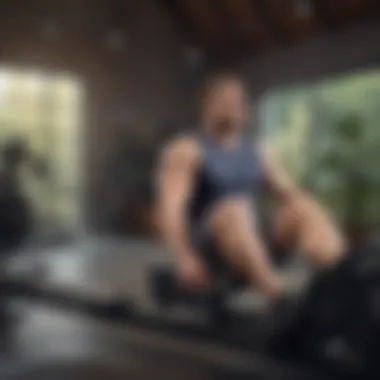Choosing Rowing Machines for Big and Tall Users


Intro
Selecting the ideal rowing machine can be a challenges for big and tall users. The fitness industry has long catered to the average frame, leaving those with larger physiques struggling to find the right equipment that meets their needs. This article aims to guide individuals in this demographic through the critical features to look for in rowing machines, addressing aspects of comfort, durability, and performance.
The importance of rowing as an exercise cannot be understated. It offers a full-body workout that is low-impact, making it suitable for individuals of various fitness levels. Knowing how to choose a rowing machine that accommodates larger users is crucial not only for effective workouts but also for preventing injuries that stem from ill-fitting equipment.
In the following sections, we will explore design inspirations that appeal to users, practical tips for maintenance and budgeting, and provide an in-depth review of brands that have successfully designed products with the bigger frame in mind.
Understanding the Requirements of Big and Tall Rowers
Selecting a suitable rowing machine requires an understanding of the specific needs of big and tall individuals. This population faces distinct challenges when it comes to exercise equipment, where comfort and functionality often intersect in complex ways. The aim is to find a rowing machine that not only accommodates size but also enhances the overall experience of rowing as an exercise.
Rowing is a low-impact workout that demands a proper fit for effective performance. When considering larger frames, it becomes important to look beyond standard specifications. Companies that manufacture rowing machines have been evolving designs and increasing capacity to serve this demographic, but they do not all meet the same standards. Therefore, identifying personal requirements is crucial for users to ensure a well-tuned choice.
Identifying Physical Needs
Big and tall rowers typically have unique physical attributes that require specific adjustments to the rowing machine. For instance, leg length and torso height significantly impact the rowing technique. The machine needs to be suited to these proportions, allowing for a full range of motion without causing strain or discomfort. It is advisable to measure inseam and overall height to assess compatibility with the machine.
Considerations during this phase may include the length of the slide rail and overall reach. A rowing machine with insufficient slide rail length can limit the effectiveness of the workout, making it impossible to achieve a proper stroke. Furthermore, the handlebar’s position must align with the user's height and arm length to foster a natural rowing motion. This alignment affects not only comfort but also engages the targeted muscle groups effectively.
Importance of Comfort in Equipment
Comfort is not merely a luxurious addition; it is essential in promoting longevity in a rowing routine. Big and tall users may encounter difficulties with poorly designed seats or handles. A seat that is too narrow or provides inadequate cushioning can lead to discomfort during workouts, causing users to avoid the machine. Thus, selecting a rowing machine with a wider seat and adjustable cushioning plays a significant role in enhancing comfort levels.
Moreover, the grip on the handle must accommodate larger hands. A handle that is too thin can cause hand fatigue, affecting performance and enjoyment. Additionally, foot platforms should be wide enough to accommodate bigger feet, and straps should secure effectively to provide stability without constriction during rowing.
Weight Capacity Considerations
Weight capacity is a critical factor when selecting a rowing machine for big and tall users. Many machines on the market have specific weight limits, and exceeding these can lead to operational problems or even accidents. Users should always verify the maximum weight rating of any rowing machine before committing to a purchase. This aspect ensures not only safety but also the durability of the equipment.
It is important to note that some brands specialize in high-capacity rowing machines, suited for individuals weighing over 300 pounds. These machines often feature sturdier frames and reinforced components, which are essential for durability and stability.
In summary, understanding the requirements of big and tall rowers encompass a holistic view of physical dimensions and comfort. This pivotal section lays the groundwork for identifying the right equipment, aimed at enhancing the rowing experience.
Key Features to Look for in Rowing Machines
When choosing a rowing machine, especially for big and tall users, specific features play a crucial role. These features impact not only performance but also comfort during workouts. An informed decision can save time, money, and prevent injuries. Understanding what to look for ensures the equipment meets the user’s unique physical requirements, enhancing both safety and effectiveness.
Frame Material and Stability
The frame material is fundamental for stability. Materials like steel or aluminum offer durability and robust construction. A sturdy design is especially important for bigger users since it needs to withstand significant weight stresses. Stability contributes to a smooth rowing experience. An unstable machine can lead to accidents and diminish workout quality.
Seat Size and Ergonomics
Comfort is paramount for any user, but it is even more critical for larger individuals. Seat size and shape must accommodate various body sizes without causing discomfort. Ergonomic design features help in proper posture, reducing strain on the back and hips. A larger seat area ensures better weight distribution, providing a stable and supportive base during rowing.
Adjustability of the Machine


Adjustability is essential for accommodating users of different heights. A rowing machine needs features that allow users to change the length of the stroke and the position of the seat. This ensures that big and tall users can find their optimal settings to maximize their performance. Proper adjustability not only enhances comfort but also improves efficiency. Machines with easy-to-use adjustments are especially beneficial, making the transition between users or settings quick and hassle-free.
Rowing Machine Types Explained
Several types of rowing machines exist, each with distinct characteristics that cater to different preferences.
Air Resistance Rowers
Air resistance rowers generate resistance by using a fan. The harder you row, the more resistance you encounter. This kind of rowing machine often appeals to users who value a natural feel during workouts. One distinct advantage is the smooth transition of resistance, which mimics real rowing conditions effectively. However, they can be noisy, which might not suit everyone's environment.
Magnetic Resistance Rowers
Magnetic resistance rowers employ magnets to control resistance levels. This type is favored for its quiet operation and smoother strokes. It is ideal for indoor workouts without disturbing others around. Magnetic systems often feature adjustable resistance settings, providing a tailored workout experience. The drawback is that they can lack the immersive feeling of rowing on water, which some users might prefer.
Water Resistance Rowers
Water resistance rowers utilize a water tank and paddles to create resistance. This type stands out because it closely replicates the experience of rowing on water. Users appreciate the soothing sound of water, which adds to the experiential aspect. However, they tend to be bulkier and require more maintenance compared to other types.
Hydraulic Resistance Rowers
Hydraulic rowing machines use hydraulic cylinders to create resistance. They are often compact and lightweight, making them a good choice for limited spaces. The adjustability in resistance levels can cater to various workout intensities. However, hydraulic machines might not offer the same longevity or durability as others. They can also provide a different stroke feel, which may not appeal to everyone.
Choosing the right features is essential for maximizing your rowing experience, especially when accommodating larger users.
Understanding these key features helps in narrowing down choices when selecting a rowing machine suited for big and tall users. With this awareness, users can ensure a machine provides not only functionality but also comfort throughout their workout routine.
Evaluating Rowing Machines: Top Recommendations
When selecting a rowing machine suitable for big and tall users, evaluation is critical. This process allows individuals to identify the best options based on personal needs and preferences. Consideration of specific features such as stability, seat size, and resistance types can significantly impact the user's experience.
Rowing machines can vary greatly in construction, ease of use, and overall performance. Therefore, understanding these nuances can lead to more informed choices, ultimately enhancing workout efficiency and comfort. Evaluating top brands helps streamline this process.
Brand A: Overview and Features
Specifications
Brand A offers a robust design characterized by its solid steel frame. This construction supports higher weight capacities, making it ideal for larger users. The extended length of the rail system also accommodates taller individuals, ensuring adequate leg extension during rowing. Users often find the display console intuitive, providing essential metrics such as time, distance, and strokes per minute. These specifications contribute positively to the overall experience, making it a popular choice for those focused on durability and performance.
Pros and Cons
Pros of Brand A include its durable frame and high weight capacity, which are essential features for big and tall users. The solid build also translates into stability during workouts, minimizing wobbling. However, a noteworthy con is the size of the machine itself. While it enhances stability, it may require more space for use and storage. This aspect may not be ideal for individuals with limited workout spaces.
Brand B: Overview and Features
Specifications
Brand B provides an alternative with its aluminum frame. This material makes the equipment relatively lightweight yet durable, facilitating easier movement and storage. The seat is designed with ample padding and a wider design, enhancing comfort for bigger users. Moreover, the machine features adjustable footrests that can accommodate various foot sizes, further tailoring the experience for different users. The ability to adjust these elements significantly enhances usability and satisfaction.
Pros and Cons


The pros of Brand B include its lightweight design, making it easy to shift, and the comfortable seat, which is crucial for longer sessions. On the downside, the stability may not match that of heavier models. Some users noted that during intense workouts, it could feel less secure. This leads to a consideration of stability versus portability that potential buyers must weigh.
Brand C: Overview and Features
Specifications
Brand C stands out for its unique resistance mechanism, combining magnetic and air resistance for a smooth rowing experience. This characteristic allows for adjustable resistance levels suited for various fitness levels and preferences. Users also appreciate the cushioned and adjustable seat, which promotes comfort. Additionally, the machine generally features a larger console that displays multiple metrics simultaneously, providing a comprehensive view of workout performance.
Pros and Cons
Pros of Brand C include its innovative resistance technology and comfort-focused design. The multiple metrics displayed help users stay informed throughout their workouts. However, a potential cons involves the complexity of the assembly process. While the instructions are straightforward, some users may find the initial setup time-consuming. This could create a barrier for those who want a quick and easy setup.
In summary, evaluating options for rowing machines involves looking at distinct features that cater to big and tall users. Each brand presents unique specifications, benefits, and drawbacks that should be carefully considered to select the best match for individual needs.
User Reviews and Feedback
User reviews and feedback play a pivotal role in selecting the best rowing machines tailored for big and tall users. Understanding what actual buyers think about the equipment can significantly influence one's decision-making process. Customer feedback encompasses a range of perspectives, offering insights into the performance, durability, and comfort of a machine. This information can be particularly valuable given the specific requirements and considerations for larger frames.
Incorporating user reviews allows potential buyers to gauge how well a rowing machine meets the unique needs of big and tall individuals. These insights can highlight whether a machine comfortably accommodates different heights and weights, whether it provides sufficient stability, and how it stands up to regular use by users who exceed average dimensions. By reviewing testimonials and feedback, one can also identify patterns in customer satisfaction or areas of concern that merit attention before purchasing.
Analyzing Customer Testimonials
When examining customer testimonials, it is essential to focus on recurring themes and sentiments shared by users. Positive testimonials often emphasize aspects like comfort, ease of use, and the effectiveness of the machine in delivering a good workout. For instance, customers may praise the adjustable features that allow them to find their optimal rowing position. They might also express satisfaction with the machine's stability during intense workouts, which can be a significant concern for larger users.
Conversely, testimonials can also reveal dissatisfaction among users. Common positive remarks may include mentions of robust frames and user-friendly controls. Therefore, when analyzing reviews, it's crucial to take a comprehensive look at how these attributes influence the overall experience of using the rowing machine. Reading multiple testimonials helps prospective buyers to create a clearer picture, balancing both positive and negative feedback.
Understanding Common Complaints
While user testimonials can provide valuable information, it is equally important to understand common complaints. For many big and tall users, specific issues tend to arise. Often, customers may report that certain rowing machines do not support heavier weights as advertised, leading to failures or diminished performance. Complaints can also surface regarding seat comfort, with some users finding the seats too narrow or uncomfortably shaped.
Other frequent issues include adjustability. If the machine lacks the necessary adjustments for height, users may feel strained during workouts, reducing the equipment's effectiveness. Moreover, the noise levels of certain rowers can be a point of contention; some individuals prefer quieter machines, particularly for at-home use.
In summary, analyzing both the favorable and unfavorable reviews from customers helps to provide a well-rounded understanding of what to look for in rowing machines designed for bigger and taller users. It also encourages thoughtful assessment when evaluating potential purchases. By weighing user feedback, new buyers can make informed decisions that cater to their specific fitness needs.
Setting Up Your Rowing Machine
Setting up your rowing machine properly is essential for both safety and performance. It maximizes the benefits of rowing and ensures that big and tall users can engage effectively with the equipment. Improper setup can hinder user experience and even lead to injury. Thus, it's crucial to understand the specific assembly and adjustment needs that cater to larger frames.
Proper Assembly Guidelines
When assembling a rowing machine, follow the manufacturer’s instructions carefully. Each model may have unique steps, but general guidelines can help simplify the process:
- Gather Tools: Collect necessary tools such as wrenches and screwdrivers before starting.
- Check Parts: Ensure that all parts are included. A checklist can help confirm that nothing is missing.
- Follow Steps: Adhere to the assembly sequence as indicated. Skipping steps may complicate the process later.
- Tighten Connections: After assembly, double-check that all bolts and screws are tight. This ensures stability during use.
- Position Correctly: Place the machine on a level surface. Uneven ground can affect the rower's stability and lead to wobbling.
This approach helps in achieving a safe and effective machine setup. Remember, a well-assembled machine not only provides safer workouts but also enhances motivation during rowing sessions.
Adjusting for Height and Weight


Adjustments are critical in accommodating big and tall users. Each individual has different height and weight specifications that must be considered.
- Seat Height Adjustment: Ensure the seat can move comfortably for the user’s leg length. The user's knees should not rise above hip level while seated.
- Footplate Positioning: The footplates should be adjustable to allow the user to secure their feet comfortably. This helps maintain balance and power throughout the rowing stroke.
- Handle Height: Check if the handle position suits the user. Taller users may require a higher positioning to avoid strain.
It is advisable to perform a trial row after adjusting the machine. This will help confirm that all settings are appropriate. A proper adjustment optimizes the rowing experience and enhances comfort, effectively reducing the risk of injury.
Incorporating Rowing into Your Fitness Routine
Incorporating rowing into a fitness routine is of paramount importance for big and tall users. Rowing not only provides an excellent workout but also supports multiple fitness goals simultaniously. This low-impact exercise is suitable for individuals of various fitness levels, making it a viable option for beginners and seasoned fitness enthusiasts alike. Notably, rowing engages various muscle groups, including the legs, back, and arms, which is essential for developing strength and endurance.
Rowing Techniques for Beginners
Beginners must understand the basic techniques of rowing to maximize benefits. Proper posture is crucial. Rowers should sit tall on the seat with shoulders relaxed and feet secured in the foot straps.
- Grip the Handle
The grip should be firm yet relaxed, avoiding excessive tension. Ideally, fingers should wrap around the handle comfortably. - Establish a Rhythm
Focus on a smooth and consistent stroke. The stroke can be divided into four phases: catch, drive, finish, and recovery. - Breathing
Coordination of breathing with strokes is vital. Inhale during the recovery phase and exhale during the drive phase.
- Catch: Slide forward on the seat, lean slightly forward, and reach for the handle.
- Drive: Push through the legs while pulling the handle towards the chest.
- Finish: Squeeze the handle near the chest and lean back slightly.
- Recovery: Extend arms, lean forward, and slide back to the starting position.
Practicing these techniques will yield better performance and lower the risk of injury in the long run.
Creating a Balanced Workout Plan
An effective rowing routine integrates strength training, cardiovascular exercises, and flexibility work for optimal results. Below are considerations for building a balanced workout plan.
- Frequency: Aim for at least three to four rowing sessions per week to build endurance steadily.
- Duration: Begin with shorter sessions, around 15-20 minutes, and gradually increase as endurance builds.
- Variation: Mix steady-state rowing with intervals. For instance, alternate between low and high intensity or mix in strength exercises, such as lunges, between rowing intervals.
- Combine rowing with rest days to allow muscle recovery.
Tip: Consider incorporating cross-training activities like swimming or cycling to diversify workouts and prevent boredom.
- Flexibility and Mobility: Include stretching and flexibility exercises at the end of each session to ensure joints and muscles benefit, particularly focusing on the hips, back, and shoulders.
By thoughtfully integrating these elements, big and tall users can enjoy the numerous benefits of rowing while creating an effective fitness regimen.
Closure: Choosing the Right Machine
Selecting the appropriate rowing machine is essential for big and tall users. As discussed throughout the article, these individuals have unique physical requirements that influence their comfort and performance during workouts. A poor choice can lead to discomfort or even injury, which negates any fitness benefits. Therefore, it is crucial to weigh various considerations when making this decision.
The importance of frame stability cannot be overstated. Machines that do not provide robust support can be dangerous, especially for users with larger frames. Likewise, seat size and adjustability determine how effectively users can engage their muscles during rowing. Additionally, understanding the different types of resistance mechanisms can impact the overall rowing experience. Knowing these factors not only helps in selecting the right machine but also ensures that users can maximize their workout potential and enjoyment.
Ultimately, the right rowing machine should accommodate the user’s specific needs. This hinges upon understanding their body type, fitness goals, and available space for the machine. A thorough assessment of these aspects will guide consumers in making informed decisions that promote both effectiveness and safety in their fitness routines.
Summary of Key Considerations
When choosing a rowing machine for big and tall users, keep the following key considerations in mind:
- Weight Capacity: Verify that the machine can support the user’s weight. Look for models that explicitly state their maximum weight limits.
- Seat Size and Comfort: A spacious and well-padded seat is vital. Ensure that the seat can accommodate larger hips and thighs.
- Stability and Build Quality: Opt for machines made of sturdy materials. Look for heavy-duty construction that can withstand intense usage.
- Adjustability: The machine should allow for height adjustments to optimize the rowing position. Customizable settings can enhance comfort and efficiency.
- Resistance Type: Each resistance type offers different challenges. Consider air, magnetic, water, and hydraulic types based on personal preference and effectiveness.
"Choosing the right rowing machine is not just about comfort. It is crucial for the overall effectiveness of the workout and injury prevention."
Final Recommendations
After reviewing various factors and machines summarized in this guide, here are some final recommendations:
- Consider the Concept2 Model D: Known for its durability and high weight capacity, it is an excellent choice for larger users.
- Look at the WaterRower Natural: This model offers a unique aesthetic with water resistance that simulates actual rowing experience.
- Evaluate the Stamina Body Trac Glider: A more compact option, it combines affordability with essential features suitable for big and tall users.















